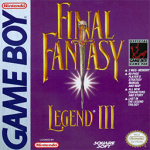Hi-ho, readers! Bringing you something completely different from last week, I shall review Final Fantasy Legend III for the Game Boy. Released on August 1993 in North America, Final Fantasy Legend III (or SaGa 3: Jikuu no Hasha as it is known in Japan) is the final game in a very loosely-connected trilogy of early Game Boy RPGs and is, as the name suggests, the third game in the SaGa series of games.
Surprisingly, FFL3 plays significantly differently from its earlier counterparts. While the first two games used weapon durabilities, a somewhat rigid class system, and heavy reliance on elements of luck, Final Fantasy Legend III uses a more traditional experience-based gameplay model with improved class flexibility. Two new classes are added to the roster, bringing the grand total up to six classes: Human, Mutant, Monster, Robot, as well as the new Beast and Cyborg classes. By utilizing various meats and parts dropped by enemies, the player is free to turn their original party of two Humans and two Mutants into any possible permutation of the six classes. No class change is permanent; it always remains possible to change a party member’s class with relative ease. The classes play rather similarly, with all classes except Monsters and Robots capable of using magic (which works now on a typical MP-based system), and all characters except Monsters being able to equip any weapon or piece of armor. Monster stats are, as in the first two games, driven by the character’s species (though their level will also play a role). Beasts, Humans and Mutants all function in relatively the same manner: all three can use any piece of equipment or any spell. Beasts also have various skills, called Talents, to make up for their low magic skills.
Beasts do more damage than other classes with martial arts-based weapons, while Humans are proficient in all other weapons, and Mutants in magic. Robots function much the same as Humans did in the original Final Fantasy Legend: they cannot use magic, and their stats are raised by giving them stat pills, purchasable in the various shops of the game. Cyborgs work, appropriately, as a fusion of the Human and Legend II‘s Robot; their stats are derived largely from their equipment. While the player cannot choose their party at the game’s start as in the previous game, the flexibility of the newer system allows for greater control of party makeup. Weapon durabilities are thankfully done away with, and equipment now functions the same as it does in any typical JRPG.
As with any Game Boy RPG, the plot of FFL3 is largely forgettable. A vaguely defined water entity is flooding the world, and in the future, most land has been flooded. A man name Borgin sends three children back in time, where a village elder raises them, along with his granddaughter, to try and stop this entity before it is too late. The plot is forgettable, though the addition of time travel does make things a bit more interesting. The party’s four generic teenagers are also forgettable, but then, this is a Game Boy game after all. The plot is, overall, less interesting than that of the previous game. Who or what the entity is is almost never directly stated, but it is eventually given a name and, unsurprisingly, becomes the game’s final boss. As with most Game Boy games, there is little to comment on: the story of FFL3 isn’t necessarily bad so much as it is nonexistent and forgettable.
The audiovisual side of FFL3 is, as with the other two games, simply fantastic. The graphics are surprisingly detailed for a Game Boy RPG, though enemy sprites are reused constantly. The backgrounds are good, though the dungeon designs are a bit bland at times. However, where FFL3 truly excels is its music. As with Final Fantasy Legend II, the Game Boy’s tiny, crappy little sound output is truly pushed to its limit here. The battle music is exciting, the boss music suitably tuned, and the final boss theme simply spectacular. Final Fantasy Legend III pushes the Game Boy’s audio capabilities as far as it can. Interestingly, this was accomplished without Nobuo Uematsu: the soundtrack here was composed by Final Fantasy Mystic Quest composer Ryuji Sasai, in tandem with Chihiro Fujioka. Indeed, much of the team from FFMQ worked on Final Fantasy Legend III, and evidence of the team’s involvement can be seen throughout, as the influence of FFMQ is prevalent.
So by now, readers, you are likely asking: “Is this old Game Boy game really worth my time?”. The answer is undoubtedly yes. If Final Fantasy Legend II fixed the problems its predecessor had, then Final Fantasy Legend III fixed all of the problems from FFL2. Whether or not III is the better game is up for debate, but it easily the most polished of the trilogy, and is most certainly a game worth checking out.



